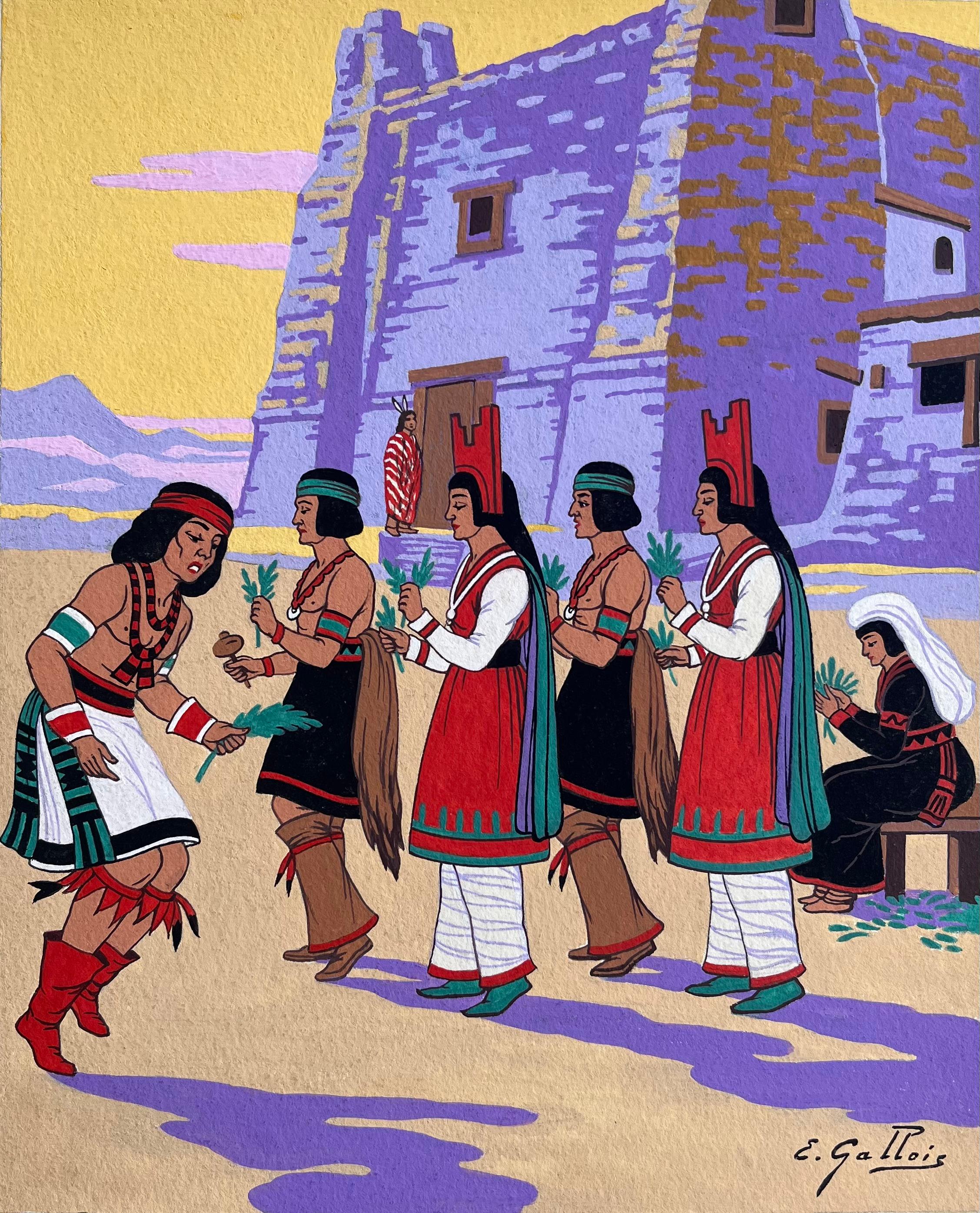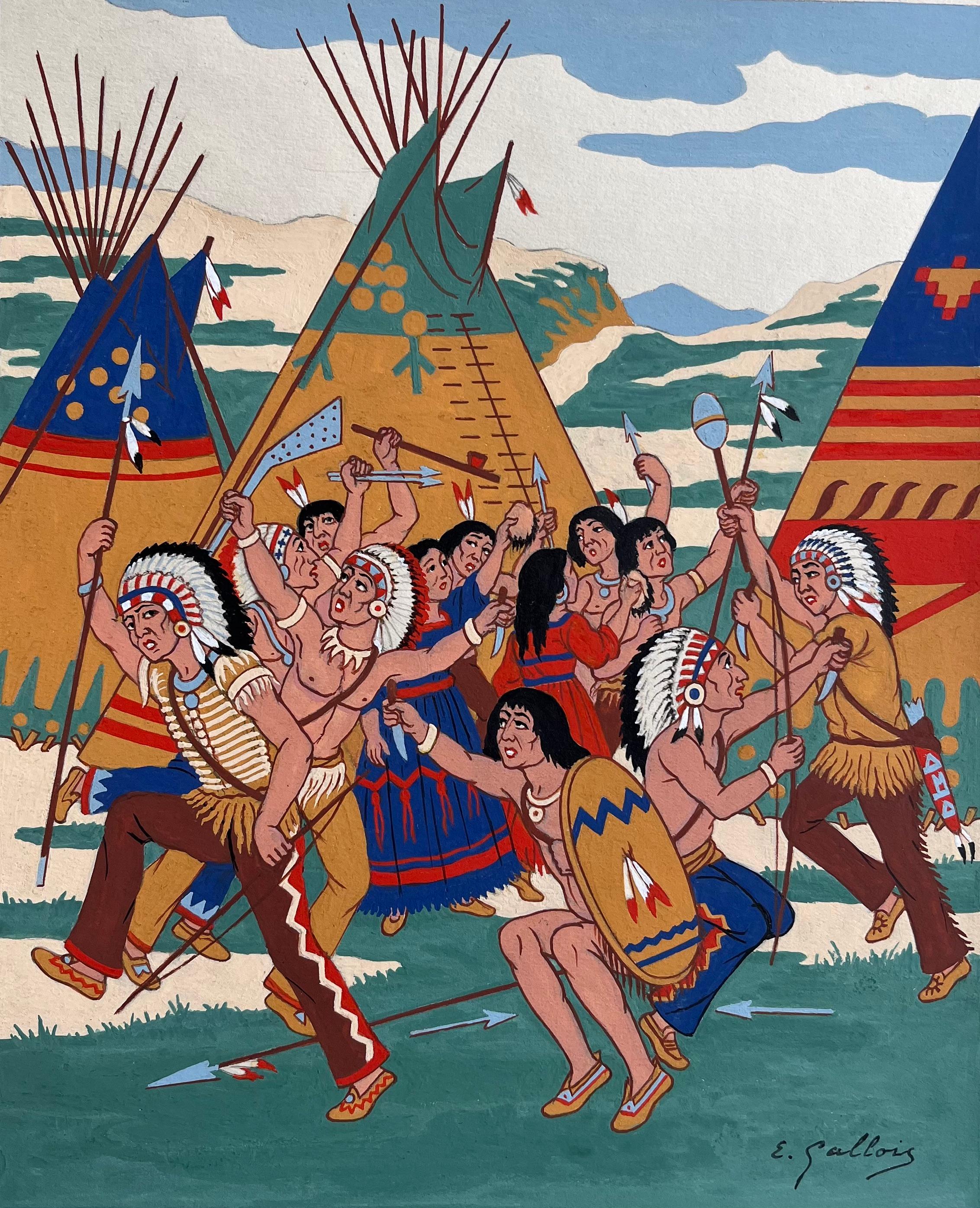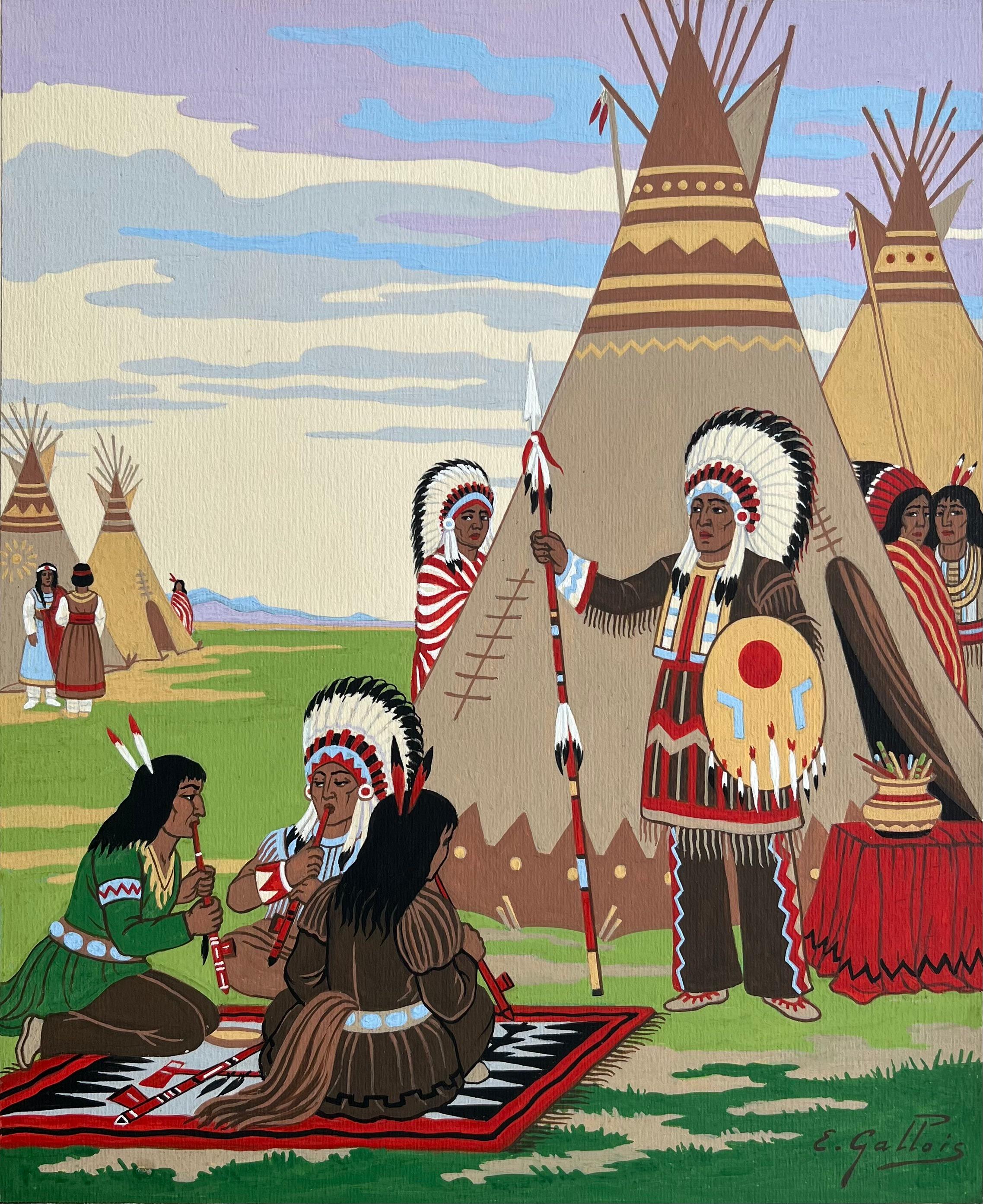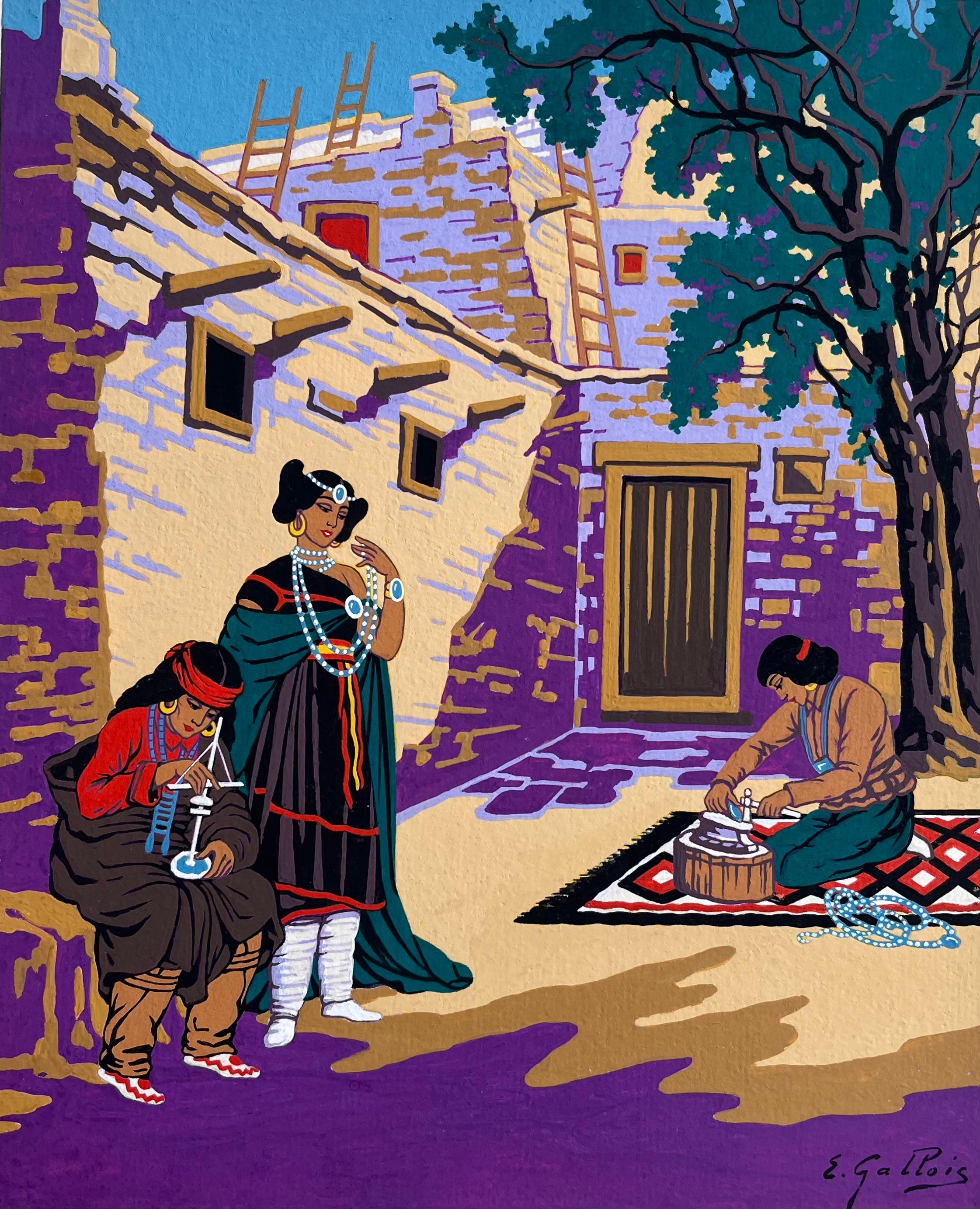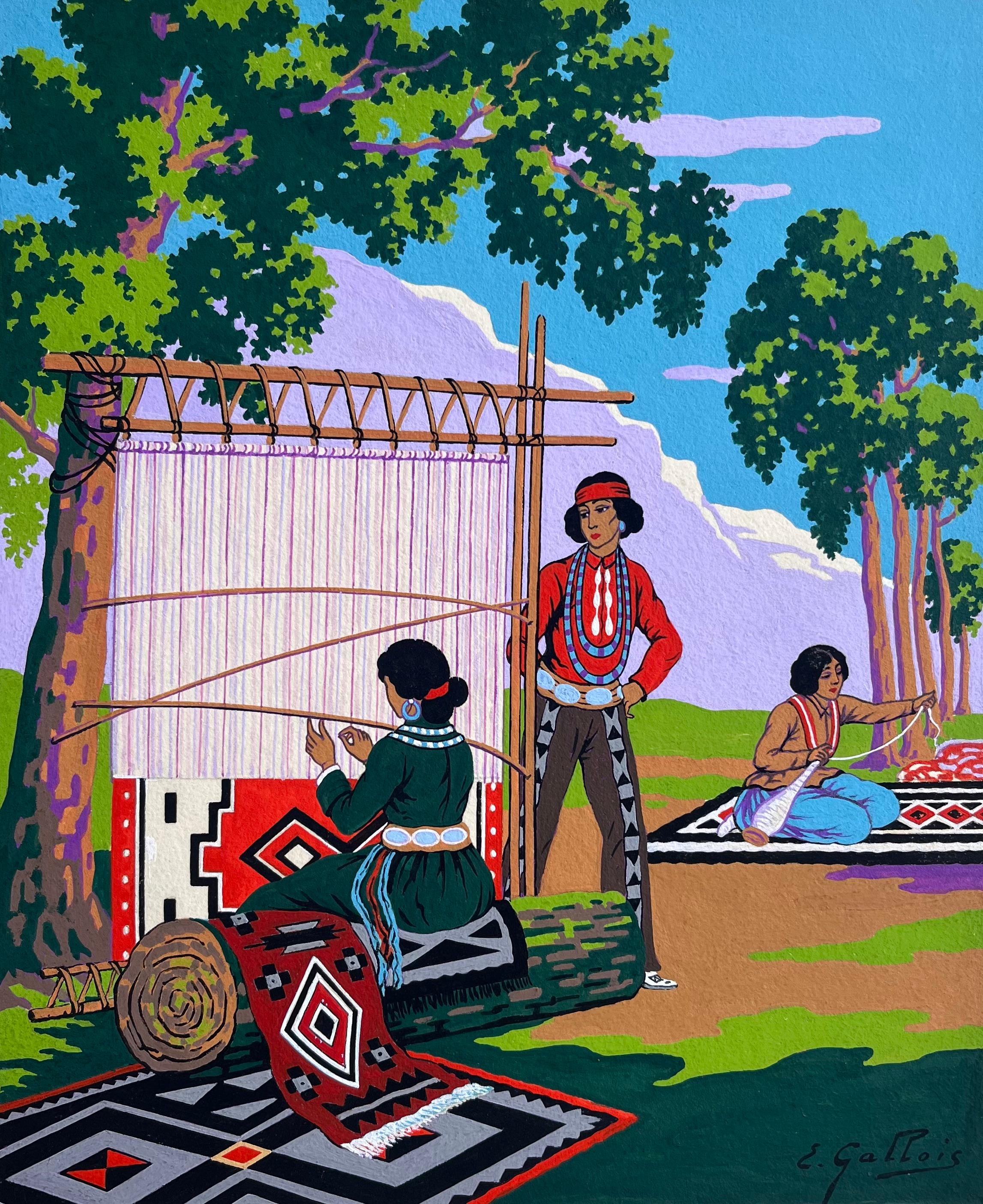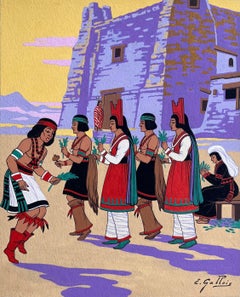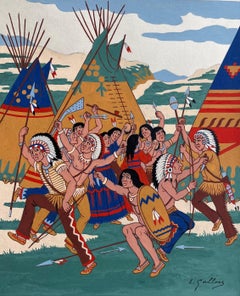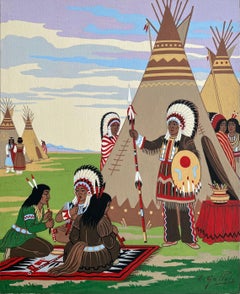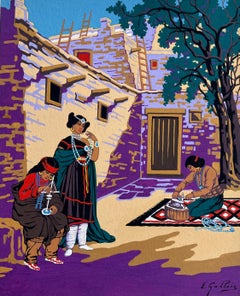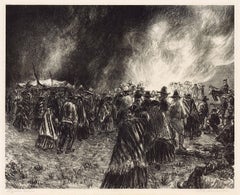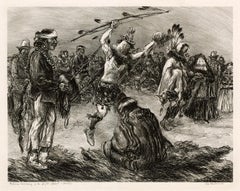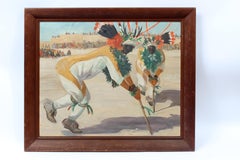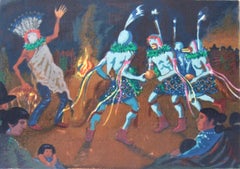Items Similar to French Gouache Painting of Navajo Night Dance in New Mexico
Want more images or videos?
Request additional images or videos from the seller
1 of 11
Emile GALLOIS (1882-1965)French Gouache Painting of Navajo Night Dance in New Mexico
$734.83
£540
€634.41
CA$1,009.53
A$1,127.05
CHF 590.55
MX$13,796.15
NOK 7,500.05
SEK 7,071.60
DKK 4,734.67
About the Item
Title: French Gouache Painting of Navajo Night Dance in New Mexico
by Emile GALLOIS (1882-1965, French)
Signed: Yes
Medium: Original gouache painting on thick unframed paper,
Size: 13.75 inches (height) x 11 inches (depth)
Conditon: Very good
Provenance: From a private French collection
Description:
This enchanting gouache painting by Emile Gallois (1882-1965) captures a Navajo night dance in New Mexico, set against the luminous glow of a starlit sky and an adobe mission-style building. The scene portrays Navajo men and women dancing in vibrant ceremonial attire, celebrating an age-old tradition of music, storytelling, and community gathering.
Key features:
Cultural & Historical Representation: A striking depiction of a Navajo night dance, a social and ceremonial event involving music, movement, and storytelling.
Traditional Attire & Accessories: The dancers wear colorful woven shawls, striped blankets, beaded jewelry, and embroidered skirts, adding to the scene's richness.
Atmospheric Composition: The deep blue night sky, dotted with twinkling stars, contrasts beautifully against the bright clothing and white-washed adobe structures.
Intricate Details: The artist masterfully conveys the fluidity of the dancers, the folds of the garments, and the warm glow emanating from the building, bringing depth and authenticity to the piece.
Collector’s Appeal: An exceptional addition for collectors of Native American cultural art, Southwestern themes, and early 20th-century ethnographic illustrations.
Gallois, a renowned French Impressionist and illustrator, exhibited widely at the Salon des Indépendants in Paris and was known for his documentary-style paintings of Indigenous and global traditions. This rare piece offers a beautiful and celebratory insight into the vibrancy of Navajo cultural expression, making it a highly desirable work.
- Creator:Emile GALLOIS (1882-1965) (1882 - 1965, French)
- Dimensions:Height: 13.75 in (34.93 cm)Width: 11 in (27.94 cm)Depth: 1 in (2.54 cm)
- Medium:
- Movement & Style:
- Period:
- Condition:
- Gallery Location:Cirencester, GB
- Reference Number:1stDibs: LU509315973632
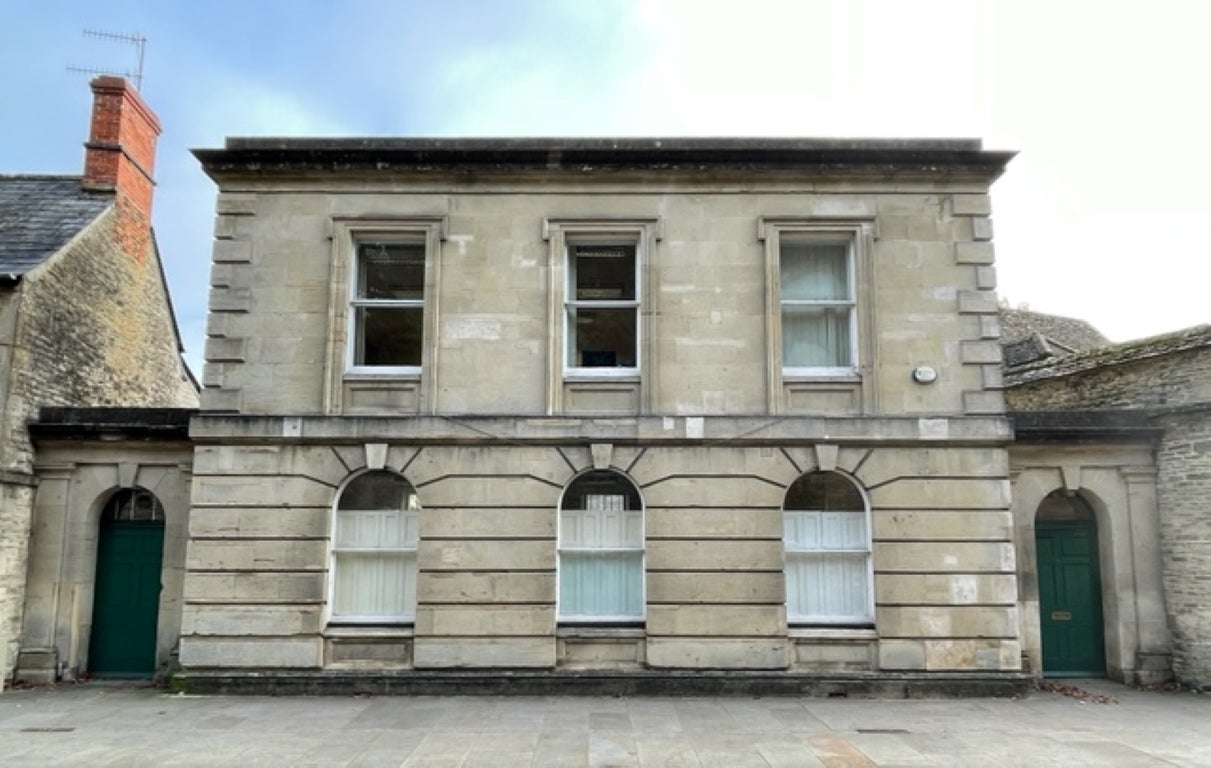
About the Seller
5.0
Platinum Seller
Premium sellers with a 4.7+ rating and 24-hour response times
Established in 1989
1stDibs seller since 2016
4,646 sales on 1stDibs
Typical response time: 1 hour
- ShippingRetrieving quote...Shipping from: Cirencester, United Kingdom
- Return Policy
Authenticity Guarantee
In the unlikely event there’s an issue with an item’s authenticity, contact us within 1 year for a full refund. DetailsMoney-Back Guarantee
If your item is not as described, is damaged in transit, or does not arrive, contact us within 7 days for a full refund. Details24-Hour Cancellation
You have a 24-hour grace period in which to reconsider your purchase, with no questions asked.Vetted Professional Sellers
Our world-class sellers must adhere to strict standards for service and quality, maintaining the integrity of our listings.Price-Match Guarantee
If you find that a seller listed the same item for a lower price elsewhere, we’ll match it.Trusted Global Delivery
Our best-in-class carrier network provides specialized shipping options worldwide, including custom delivery.More From This Seller
View AllFrench Gouache Painting of Acoma Pueblo Corn Dance in New Mexico
Located in Cirencester, Gloucestershire
Title: French Gouache Painting of Acoma Pueblo Corn Dance in New Mexico
by Emile GALLOIS (1882-1965, French)
Signed: Yes
Medium: Original gouache painting on thick unframed paper,
Si...
Category
Mid-20th Century American Modern Figurative Drawings and Watercolors
Materials
Gouache
French Gouache Painting of Sioux Scalp Dance Ritual in South Dakota
Located in Cirencester, Gloucestershire
Title: French Gouache Painting of Sioux Scalp Dance Ritual in South Dakota
by Emile GALLOIS (1882-1965, French)
Signed: Yes
Medium: Original gouache painting on thick unframed paper,...
Category
Mid-20th Century American Modern Figurative Drawings and Watercolors
Materials
Gouache
French Gouache Painting of Indigenous Council Gathering in Colorado Nevada
Located in Cirencester, Gloucestershire
Title: French Gouache Painting of Indigenous Council Gathering in Colorado Nevada
by Emile GALLOIS (1882-1965, French)
Signed: Yes
Medium: Original gouache painting on thick unframed...
Category
Mid-20th Century American Modern Figurative Drawings and Watercolors
Materials
Gouache
Vibrant French Gouache Painting of Navajo Jewelry Makers in Albuquerque
Located in Cirencester, Gloucestershire
Title: Vibrant French Gouache Painting of Navajo Jewelry Makers in Albuquerque
by Emile GALLOIS (1882-1965, French)
Signed: Yes
Medium: Original gouache painting on thick unframed p...
Category
Mid-20th Century American Modern Figurative Drawings and Watercolors
Materials
Gouache
French Gouache Painting of Navajo Weavers in Canyon de Chelly Arizona
Located in Cirencester, Gloucestershire
Title: French Gouache Painting of Navajo Weavers in Canyon de Chelly Arizona
by Emile GALLOIS (1882-1965, French)
Signed: Yes
Medium: Original gouache painting on thick unframed pape...
Category
Mid-20th Century American Modern Figurative Drawings and Watercolors
Materials
Gouache
French Gouache Painting of Pueblo Bread Baking in Taos New Mexico
Located in Cirencester, Gloucestershire
Title: French Gouache Painting of Pueblo Bread Baking in Taos New Mexico
by Emile GALLOIS (1882-1965, French)
Signed: Yes
Medium: Original gouache painting on thick unframed paper,
S...
Category
Mid-20th Century American Modern Figurative Drawings and Watercolors
Materials
Gouache
You May Also Like
'Navajo Courtship Dance' — Southwest Regionalism, American Indian
By Ira Moskowitz
Located in Myrtle Beach, SC
Ira Moskowitz, 'Navajo Courtship Dance (Squaw Dance)', lithograph, 1946, edition 30, Czestochowski 161. Signed and titled in pencil. Signed and dated in the stone, lower left. A fine, richly-inked impression, on cream wove paper; the full sheet with margins (7/16 to 2 3/4 inches). Pale mat line, otherwise in excellent condition. Matted to museum standards, unframed.
Image size 11 13/16 x 14 13/16 inches (300 x 376 mm); sheet size 13 1/16 x 20 1/8 inches (332 x 511 mm).
ABOUT THE ARTIST
Ira Moskowitz was born in Galicia, Poland, in 1912, emigrating with his family to New York in 1927. He enrolled at the Art Student's League and studied there from 1928-31. In 1935, Moskowitz traveled to Paris and then lived until 1937 in what is now Israel. He returned to the United States in 1938 to marry artist Anna Barry in New York. The couple soon visited Taos and Santa Fe in New Mexico, returning for extended periods until 1944, when they moved there permanently, staying until 1949. During this especially productive New Mexico period, Moskowitz received a Guggenheim fellowship. His work was inspired by the New Mexico landscape and the state’s three cultures (American Southwest, Native American, and Mexican). He focused on Pueblo and Navajo life, producing an extensive oeuvre of authentic American Indian imagery. He and Anna also visited and sketched across the border in Old Mexico. While in the Southwest, Moskowitz flourished as a printmaker while continuing to produce oils and watercolors. Over 100 of Moskowitz’s works depicting Native American ceremonies were used to illustrate the book American Indian Ceremonial Dances by John Collier, Crown Publishers, New York, 1972.
After leaving the Southwest, printmaking remained an essential medium for the artist while his focus changed to subject matter celebrating Judaic religious life and customs. These works were well received early on, and Moskowitz was content to stay with them the rest of his life. From 1963 until 1966, Moskowitz lived in Paris, returning to New York City in 1967, where he made his permanent home until he died in 2001.
Shortly before his death, Zaplin-Lampert Gallery of Santa Fe staged an exhibition of the artist's works, December 2000 - January 2001. Other one-person shows included the 8th Street Playhouse, New York, 1934; Houston Museum, 1941; and the San Antonio Museum, 1941. The artist’s work was included in exhibitions at the Art Students League, Art Institute of Chicago, Philadelphia Print Club, College Art Association (promotes excellence in scholarship and teaching), and the International Exhibition of Graphic Arts (shown at MOMA, 1955).
Moskowitz’s lithographs of...
Category
1940s American Modern Landscape Prints
Materials
Lithograph
'Navajo Medicine Ceremony of the Night Chant' — Southwest Regionalism
By Ira Moskowitz
Located in Myrtle Beach, SC
Ira Moskowitz, 'The Three Gods of Healing (Navajo Medicine Ceremony of the Night Chant)', lithograph, 1945, edition 30, Czestochowski 148. Signed and titled in pencil. Signed and dated in the stone, lower right. A fine, richly-inked impression, on cream wove paper, with full margins (2 1/4 to 2 3/4 inches), in excellent condition. Matted to museum standards, unframed.
Image size 12 1/4 x 15 13/16 inches (311 x 402 mm); sheet size 17 1/8 x 20 7/8 inches (435 x 530 mm).
ABOUT THIS WORK
The nine-night ceremony known as the Night Chant or Nightway is believed to date from around 1000 B.C.E. when it was first performed by the Indians who lived in Canyon de Chelly (now eastern Arizona). It is considered the most sacred of all Navajo ceremonies and one of the most difficult and demanding to learn, as it encompasses hundreds of songs, dozens of prayers, and several highly complex sand paintings. And yet the demand for Night Chants is so great that as many as fifty such ceremonies might be held during a single winter season, which lasts eighteen to twenty weeks.
The Night Chant is designed both to cure people who are ill and to restore the order and balance of human and non-human relationships within the Navajo universe. Led by a trained medicine man who has served a long apprenticeship and learned the intricate and detailed practices that are essential to the chant, the ceremony itself is capable of scaring off sickness and ugliness through techniques that shock or arouse. Once the disorder has been removed, order and balance are restored through song, prayer, sand painting, and other aspects of the ceremony.
The medicine men who supervise the Night Chant ensure that everything—each dot and line in every sand painting, each verse in every song, each feather on each mask is arranged precisely, or it will not bring about the desired result. There are probably as many active Night Chant medicine men today as at any time in Navajo history due to the general increase in the Navajo population, the popularity of the ceremony, and the central role it plays in Navajo life and health.
ABOUT THE ARTIST
Ira Moskowitz was born in Galicia, Poland, in 1912, emigrating with his family to New York in 1927. He enrolled at the Art Student's League and studied there from 1928-31. In 1935, Moskowitz traveled to Paris and then lived until 1937 in what is now Israel. He returned to the United States in 1938 to marry artist Anna Barry in New York. The couple soon visited Taos and Santa Fe in New Mexico, returning for extended periods until 1944, when they moved there permanently, staying until 1949. During this especially productive New Mexico period, Moskowitz received a Guggenheim fellowship. His work was inspired by the New Mexico landscape and the state’s three cultures (American Southwest, Native American, and Mexican). He focused on Pueblo and Navajo life, producing an extensive oeuvre of authentic American Indian imagery. He and Anna also visited and sketched across the border in Old Mexico. While in the Southwest, Moskowitz flourished as a printmaker while continuing to produce oils and watercolors. Over 100 of Moskowitz’s works depicting Native American ceremonies were used to illustrate the book American Indian Ceremonial Dances by John Collier, Crown Publishers, New York, 1972.
After leaving the Southwest, printmaking remained an essential medium for the artist while his focus changed to subject matter celebrating Judaic religious life and customs. These works were well received early on, and Moskowitz was content to stay with them the rest of his life. From 1963 until 1966, Moskowitz lived in Paris, returning to New York City in 1967, where he made his permanent home until he died in 2001.
Shortly before his death, Zaplin-Lampert Gallery of Santa Fe staged an exhibition of the artist's works, December 2000 - January 2001. Other one-person shows included the 8th Street Playhouse, New York, 1934; Houston Museum, 1941; and the San Antonio Museum, 1941. The artist’s work was included in exhibitions at the Art Students League, Art Institute of Chicago, Philadelphia Print Club, College Art Association (promotes excellence in scholarship and teaching), and the International Exhibition of Graphic Arts (shown at MOMA, 1955).
Moskowitz’s lithographs of...
Category
1940s American Modern Landscape Prints
Materials
Lithograph
American Painting Native American Dance Exhibition New Mexico Antelope Dancers
Located in Buffalo, NY
An original oil painting by American artist Rudolph Wedow. This fantastic painting depicts Antelope Dancers in San Felipe Pueblo in New Mexico.
Created...
Category
1940s American Impressionist Figurative Paintings
Materials
Oil, Board
Anna Barry, Navajo Yei Bei Chai
By Anna Barry
Located in New York, NY
Anna Barry (1907-2001), and her husband, the artist Ira Moskovitz, spent years in New Mexico in the late 1930s and 40s. They returned permanently to New York City in 1949.
The screen print (also known as silk screen or serigraph) Navajo Yei...
Category
Mid-20th Century American Modern Figurative Prints
Materials
Screen
'Navajo Family', Santa Fe, Modernism, Corcoran, Whitney, PAFA, AIC, WPA
By Eduard Buk Ulreich
Located in Santa Cruz, CA
Signed lower center, 'by Buk' for Eduard Buk Ulreich (American, 1889-1966), dedicated lower center, 'for Ruth' and painted circa 1945. Additionally signed and titled verso 'Navajo Fa...
Category
1940s Art Deco Figurative Drawings and Watercolors
Materials
Illustration Board, Gouache, Watercolor
Apache Mountain Spirit Dancers, lithograph, Apache, Allan Houser Haozous black
By Allan Houser
Located in Santa Fe, NM
Apache Mountain Spirit Dancers, lithograph, Apache, Allan Houser Haozous black
Hand colored original lithograph edition by Allan Houser
hand printed in Santa Fe, New Mexico
Allan Houser (Haozous), Chiricahua Apache (1914-1994)
Selected Collections
Centre Georges Pompidou, Paris, France * “They’re Coming”, bronze
Dahlem Museum, Berlin, Germany
Japanese Royal Collection, Tokyo, Japan “The Eagle”, black marble commissioned by President William J. Clinton
United States Mission to the United Nations, New York City, NY *"Offering of the Sacred Pipe”, monumental bronze by Allan Houser © 1979 Presented to the United States Mission to the United Nations as a symbol of World Peace honoring the native people of all tribes in these United States of America on February 27, 1985 by the families of Allan and Anna Marie Houser, George and Thelma Green and Glenn and Sandy Green in New York City.
National Portrait Gallery, Smithsonian, Washington, DC * Portrait of Geronimo, bronze
National Museum of American Art, Smithsonian, Washington, D.C. * “Buffalo Dance Relief”, Indiana limestone...
Category
1970s Contemporary Figurative Prints
Materials
Color Pencil, Lithograph
More Ways To Browse
New Mexican Artist
New Mexico Artists
New Mexico Paintings
Dancer In Blue
Paintings Of Modern Dancers
Mexican Vibrant Painting
Mexican Mid Century Painting
Women Dancing Painting
Native Dance
Men Dancing
Native American Dancer
Navajo Artists
American Southwestern Artists
Mexican Bead
Navajo Paintings
Southwestern Art New Mexico
Mexican Gouache
Navajo Art Painting
